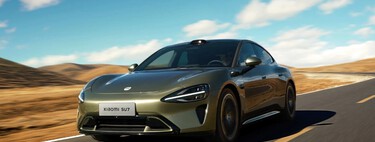The Xiaomi SU7 is, without a doubt, one of the revelations of the year. Since its launch, the technology company’s electric car has captured all eyes in China. To begin with, because the car has been put on the street in record time. And, second, for promising amazing benefits.
Presented at the end of 2023, Xiaomi revealed all the details of its Xiaomi SU7 in an event that seemed to have no end and in which it released figures to the public like Perseids fall on a summer night.
In its presentation, the company did not hesitate to point to Porsche or Tesla. “By working hard for the next 15 to 20 years, we will become one of the top five manufacturers of automobiles in the world,” Lei Jun himself, CEO of Xiaomi, said at the event.
In the deployment, Xiaomi surprised by the variety of versions. The most modest has a single motor with 222 kW (299 HP) and the battery is 73.6 kWh in size. The most powerful option is the Xiaomi SU7 Max, with a double motor to produce up to 500 kW (673 HP) that is combined with a 101 kWh battery.
The middle point is found in the Xiaomi SU7 Pro. In this case, only one motor is mounted but the battery grows to 94.3 kWh in size, so the relationship between price, autonomy and power should be the same. best of all. In 2025, they also hope to offer a car with a single engine capable of generating 570 HP.
But leaving aside the pure power figures, Xiaomi had another challenge ahead: the autonomy. This point, as workers from other Chinese manufacturers such as BYD have explained to us, is not so decisive in China because there the distances are enormous and long trips are usually reserved for the train or plane.
For this reason, some Chinese cars suffer from less autonomy and a reduced size of their trunk, in favor of the rear seats. In China, the comfort of the rear seats is usually prioritized because trips in the urban environment are extraordinarily long. However, autonomy, although important, is not as decisive as in Europe or the United States.
All in all, if Xiaomi wanted to make the leap to European soil, it had no choice but to also comply in this section. And, with the first evidence that we receive, it seems that she has achieved it.
A Xiaomi Su7 Pro that is a reference for autonomy
Although we will have to continue waiting to see a Xiaomi with one of CATL’s semi-solid batteries like those that have already been tested in cars like the NIO ET7 (Xiaomi as well he promised), the first tests in real conditions begin to indicate that we are facing a very capable car.
A few weeks ago, Car News China claimed that, in real driving tests, the car Xiaomi surpassed BYD or Tesla in autonomy. According to their accounts, the Xiaomi SU7 Max, with a 101 kWh battery, could travel up to 643 kilometers. The figure was higher than those of the Tesla Model 3, the NIO ET5 or the BYD Han.
But Xiaomi’s electric car was also the second one that deviated the least from the expected range. According to the Chinese homologation cycle, the vehicle should reach a range of 800 kilometers. Therefore, it was 79.4% away from achieving it. A very good figure, considering the particularities of this misleading homologation cycle. It was also the third best brand in the test, only surpassed by the Tesla Model 3 (79.7%) and the XPeng P7 (80.2%).
But, to this test, we now add another one carried out by a Chinese blogger who has examined the Pro version of the Xiaomi SU7 on the open road already at constant speed of 120 km/h. This comparison has been echoed by our colleagues from Xiaomi World and it has been shown that the Pro model is really capable on the highway, where we most need the autonomy of an electric car.
The Max has a 101 kWh battery and 800 Volt structure, which allows extraordinarily high loads. The Pro has a 94.3 kWh 400 Volt battery installed but, nevertheless, it is capable of recharging at a very powerful 295 kW. A figure that is far from most European cars.
According to this test, the driver managed to travel 599 kilometers at a stretch with his Xiaomi SU7 Pro. During this time, he used cruise control to maintain a constant speed of 120 km/h, leaving the average speed at 103 km/h. This figure, although it may not seem like it, is very high for a test and was only affected by a stop on a toll road and at a service station.
With this data, the Xiaomi SU7 Pro consumed 15.6 kWh/100 km. A very good figure that is similar to what can be achieved with a Tesla Model 3. The colleagues of km77one of the references in consumption tests, ensure that the model from Elon Musk’s firm generally moves between 14 and 18 kWh/100 km.
We must not lose sight of the fact that the Tesla Model 3 is one of the most efficient cars on the market, so the figures for this Xiaomi SU7 Pro are really good. Right now, not many European or American cars can travel 600 kilometers without stopping to recharge.
Photo | Xiaomi
In Xataka | I have seen Xiaomi’s electric car up close: the SU7 is clear proof of the brand’s future















![[Img #74661]](https://thelatestnews.world/wp-content/uploads/2024/12/The-power-of-ultrasound-300x200.jpg)
Add Comment